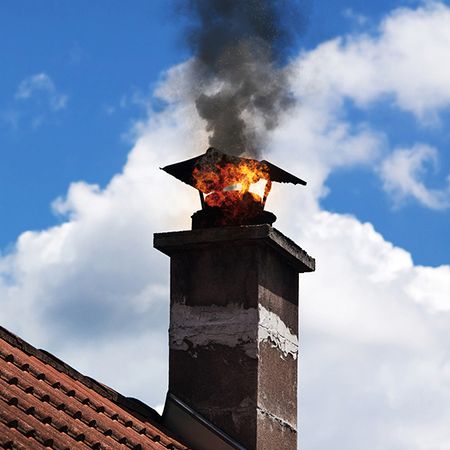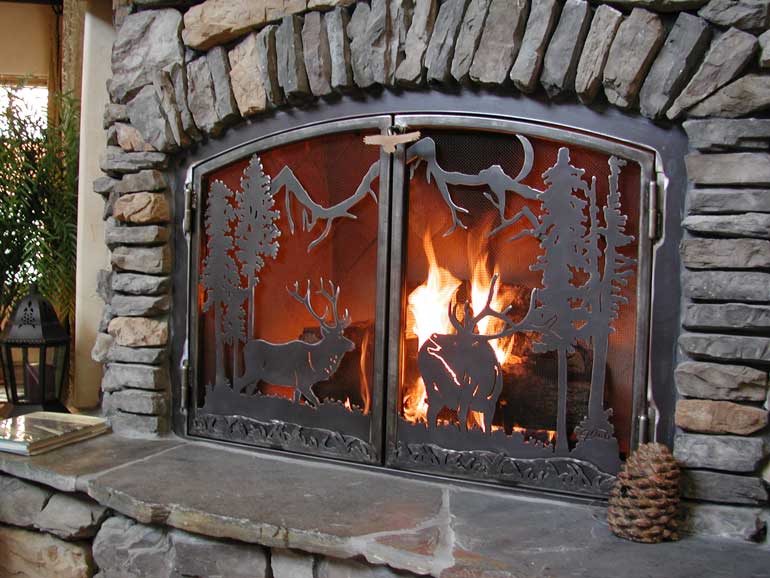During a chimney fire, it’s important to have accurate information about effective methods to extinguish the flames. One common question that arises is whether salt can be used to put out a chimney fire. In this article, we’ll explore the efficacy of using salt in extinguishing chimney fires and discuss its limitations. While salt can be effective in smothering flames and cutting off the fire’s oxygen supply, it’s crucial to understand the proper application and potential risks involved. By the end of this article, you’ll have a clear understanding of using salt to combat chimney fires and ensuring the safety of your fireplace.
Key Takeaways: Does Salt Put Out a Chimney Fire
- Chimney fires can occur due to creosote buildup from burned wood.
- Salt can be used to extinguish small chimney fires, but it may not work for larger fires.
- Water should not be used to extinguish a chimney fire as it can worsen the fire.
- It is important to evacuate the home and call the fire department for assistance in extinguishing a chimney fire.
Chimney Fires: Causes and Prevention
To prevent chimney fires, regularly clean your chimney and remove creosote buildup. Creosote is a tar-like substance that accumulates from burned wood and is a major cause of chimney fires. Signs of a chimney fire include loud cracking noises, thick smoke, flaming bits falling into the fireplace, and a roaring sound. Call the fire department immediately and evacuate if a chimney fire occurs. Alternative methods to extinguish chimney fires include using baking soda, salt, or sand. Close the damper and turn off HVAC systems during a chimney fire. Chimney inspections help identify and address potential hazards. Practice proper wood-burning techniques and schedule regular cleanings and inspections to reduce the risk of chimney fires.
Does salt put out a chimney fire?
Salt can effectively extinguish smaller chimney fires by cutting off the fire’s oxygen supply. It has a high melting point, allowing it to withstand the heat generated by the fire. Baking soda is an alternative that can also be used to smother and reduce oxygen levels in chimney fires. Both salt and baking soda are readily available household items for emergency use. When using salt, ensure you have enough to cover the entire fire and pour it into a larger container before dousing the flames. However, it is important to prioritize safety and call the fire department for assistance, especially for larger fires. Salt or baking soda should be seen as a temporary measure until professionals arrive.
Warning: Do Not Use Water
When dealing with a chimney fire, avoid using water as it can be extremely dangerous and worsen the situation. Instead, use alternatives like salt or baking soda to smother the fire safely. In case of a larger fire, call the fire department for assistance and prioritize evacuation for everyone’s safety. Additionally, consider proper firewood selection, regular fireplace maintenance, and professional chimney inspections to prevent chimney fires.
- Avoid using water to extinguish a chimney fire
- Use alternatives like salt or baking soda to smother the fire
- Call the fire department for assistance in case of a larger fire
- Prioritize evacuation for everyone’s safety
- Consider proper firewood selection, regular fireplace maintenance, and professional chimney inspections to prevent chimney fires.
Importance of Evacuation and Fire Department
Why prioritize safety and let professionals handle a chimney fire?
- Evacuation safety: Immediate evacuation after using salt or baking soda to extinguish the fire ensures everyone’s safety and prevents potential harm.
- Fire department assistance: It is important to stay outside until the fire department arrives and examines the chimney. They have the expertise and equipment to effectively extinguish the fire and assess any damage.
- Professional handling: Prioritizing safety and letting trained professionals handle the situation is crucial. Chimney fires can be dangerous and unpredictable, so it is best to rely on experts who can handle the situation safely and efficiently.
Benefits of Using Salt to Douse the Flames
Using salt to extinguish flames offers several benefits.
- Salt can smother smaller, contained flames and has a high melting point of over 1,400 degrees Fahrenheit.
- By applying a large amount of salt to the flames, it kills the fire’s oxygen supply, quickly and safely extinguishing the fire.
- This results in less soot and a cleaner chimney.
- Salt is a cost-effective solution that is readily available in most kitchens.
To summarize, the benefits of using salt to douse flames in a chimney fire include smothering flames, high melting point, quick and safe extinguishing, less soot, and cost-effectiveness.
Using Salt for Easier Clean Up
Using salt or baking soda after a chimney fire can make cleanup easier for the following reasons:
- Clumping ashes together: Salt helps clump the ashes together, making them easier to sweep up compared to loose ashes.
- Readily available in most kitchens: Salt is readily available in most kitchens, making it a convenient option for cleanup. Simply sprinkle a handful of salt over the ashes.
- Baking soda as an alternative: If salt is not available, baking soda can be used as an alternative. It releases carbon dioxide when heated, reducing oxygen levels and smothering the fire, similar to salt.
Remember to store the salt properly for future fireplace maintenance and follow safety precautions when using it.
Other Ways to Manage Fireplace Messes
Using fire screens can effectively contain soot, ashes, and debris, minimizing the mess in your fireplace. Fire screens act as a barrier, preventing particles from escaping into your living space. Choosing the right wood and burning materials can also help manage fireplace messes. Opt for hardwoods that produce less soot and ash compared to softwoods like pine or cedar. Regular fireplace maintenance is important to prevent excessive buildup of soot and debris.
Vacuuming the fireplace to clean up ashes is another effective method. Combining multiple cleaning methods, such as using a fire screen and vacuuming ashes, can achieve optimal results. However, it is essential to follow safety precautions when using salt in combination with a fire screen. Ensure you have enough salt to cover the entire fire, use caution when handling and applying it, and only use salt for larger fires. Salt is a cost-effective and readily available solution for managing fireplace messes.
Safety Considerations When Using Salt
To effectively extinguish a chimney fire using salt, it is important to follow these safety guidelines:
- Caution with the melting point: Salt has a high melting point of over 1,400 degrees Fahrenheit. However, it can still become hot when in contact with the fire. Handle and apply salt with caution.
- Handling and applying: Pour the salt into a larger bowl or container before dousing the flames. Avoid sprinkling or grinding salt directly on the fire to prevent the spread of flames.
- Safety precautions for larger fires: Salt is most effective for larger and out-of-control fires. For smaller fires, consider using other methods and prioritize safety. If needed, call the fire department for assistance.
Cost-Effective and Readily Available Solution
Salt is an affordable and easily accessible solution for fireplace maintenance. It is a cost-effective alternative to specialized cleaning products and can be found in most kitchen pantries. Using salt for fireplace maintenance does not require any additional purchases, saving you money in the long run. Additionally, salt is readily available and can be easily stored for future use. It has the benefits of smothering flames, extinguishing fires, and clumping ashes together for easier clean-up. With salt as a readily available and effective solution, you can maintain your fireplace without breaking the bank.
Steps on Using Burning Rock Salt to Clean Chimney Creosote
To clean chimney creosote effectively, follow these steps:
- Choose kiln-dried firewood to prevent creosote buildup and ensure efficient burning.
- Properly prepare your fireplace by arranging logs, releasing the damper, and removing any ashes from previous sessions.
- Utilize proper fire lighting techniques, starting with small flames using newspaper or kindling to minimize smoke and creosote buildup. Gradually increase the fire size while maintaining control.
Remember to also consider alternative cleaning methods, such as using creosote removing substances or professional chimney sweeping. Regular chimney inspections are crucial to maintaining safety and preventing creosote buildup.
Frequently Asked Questions
Can Salt Be Used to Put Out a Chimney Fire Caused by Burning Softwoods Like Pine or Cedar?
Salt can effectively extinguish chimney fires caused by burning softwoods like pine or cedar. When applied in large amounts, salt smothers the flames by depleting oxygen, resulting in a safer and cleaner chimney.
Is It Safe to Use Salt on a Chimney Fire That Is Already Out of Control?
Using salt on a chimney fire that is already out of control is safe. Salt can smother the flames by cutting off the oxygen supply. However, it is important to prioritize safety and call the fire department for assistance.
What Are Some Alternative Methods for Managing Fireplace Messes Besides Using Salt?
Consider using an ash vacuum or chimney brush to manage fireplace messes. Installing fireplace screens and chimney caps can help contain debris. Another option is to use chimney cleaning logs or hire professional chimney cleaning services for effective solutions.
Are There Any Safety Precautions to Consider When Handling and Applying Salt to a Chimney Fire?
When handling and applying salt to a chimney fire, follow safety precautions. Properly handle and pour salt onto the fire for effectiveness. Consider the risk of softwoods and explore alternative methods for managing fireplace messes.
Can Salt Be Used to Clean Creosote Deposits in the Chimney?
Yes, salt can effectively clean creosote deposits in the chimney. The chemical reactions between salt and creosote help break it down for easier removal.










